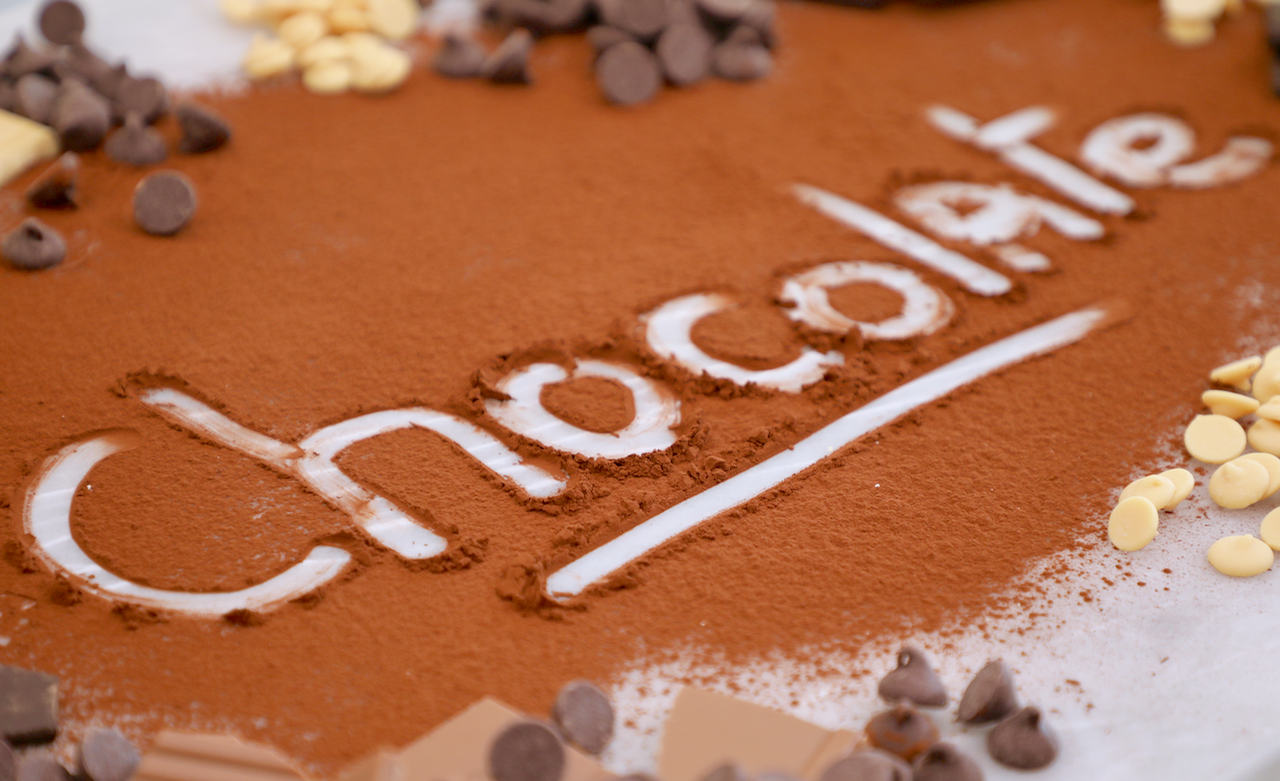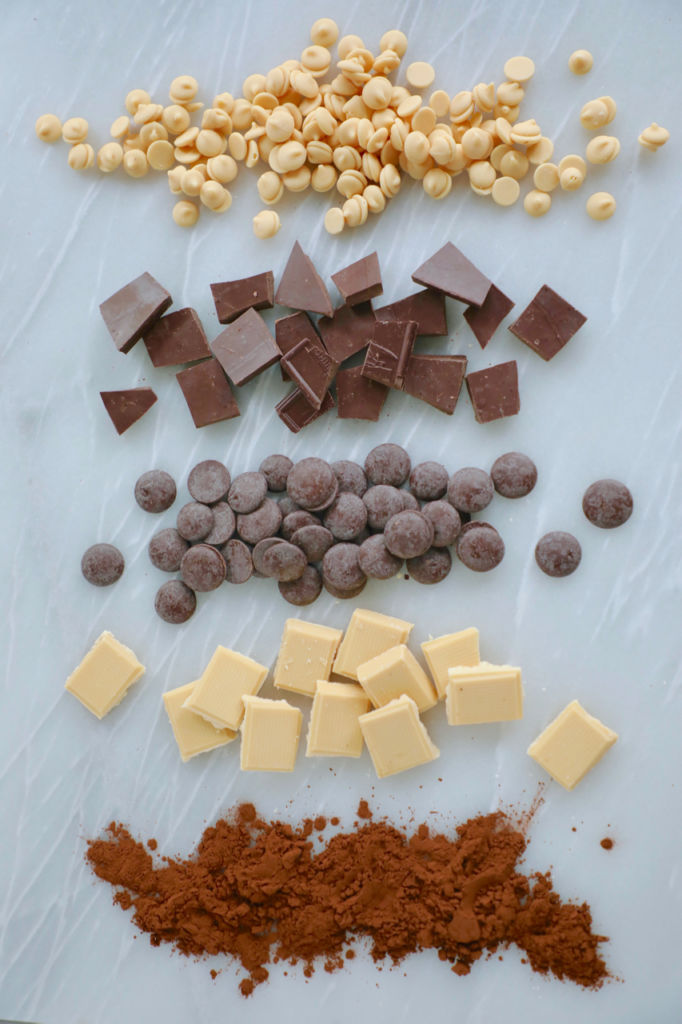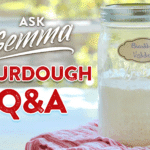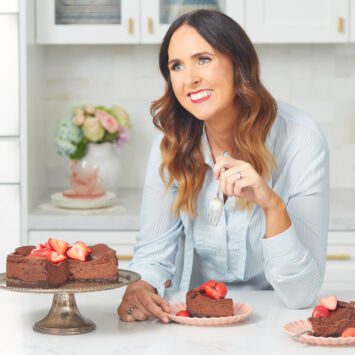
This post may contain affiliate links. Please see my full disclosure for details.
Hi Bold Bakers!
Information about the Types of Chocolate is not something we think we need, right? But as Bold Bakers, you need to know a few things. Not all chocolate is created equal! So, how do you know what to use and when to use it?
I have the answers! Let’s take a deep dive on the Ultimate Guide to the Different Types of Chocolate and clear up any questions you might have about which chocolate is which and what you should be using in your baking.
The Different Types of Chocolate
When it comes to baking with the different types of chocolate, you need to pay attention to what types of chocolate the recipe is calling for. Is it bittersweet? Or semi-sweet? Each chocolate is graded by its cocoa solid percentage. Knowing what the cocoa solid percentages actually mean will tell you exactly what type of chocolate you are dealing with.
These are fun facts about chocolate that every Bold Baker should know:
Milk Chocolate (38 – 42 % cocoa solids)
Milk chocolate is most commonly known as “eating chocolate.” With more sugar added than other types of chocolate, it tends to be on the sweeter side — and less chocolatey. Milk chocolate usually ranges between 38% and 42% cocoa but can have as little as 10% cocoa solids. If you don’t like your chocolate bitter then this chocolate is for you. This chocolate works great in my S’more Fudge recipe.
Semisweet (52 – 62 % cocoa solids)
Semisweet chocolate is entry level for those who are new to the darker, more pronounced chocolate flavor. Most commonly found in chip form, they are a standard ingredient in most kitchens. With its sweet flavor and creamy consistency, it is a dream to work with. It melts easily, combines well with other flavors, and is fantastic for dipping. I use this chocolate in my S’more Cheesecake and Chocolate Chip Cookie Pie
Bittersweet Chocolate (63 – 72 % cocoa solids)
This is my go-to chocolate. Darker and more pronounced in flavor than a semisweet, bittersweet is many chefs’ favorite. However, their higher cocoa solid percentage can make them trickier to work with. With a cocoa solid percentage ranging from 63 – 72%, I find that Bittersweet Chocolate has the perfect balance of bitter and sweet — which makes sense because just look at the name! I think this chocolate works best in my recipes for Best Ever Chocolate Chip Cookies and German Chocolate Cake
Unsweetened Chocolate (100% cocoa solids)
Unsweetened chocolate, as the name implies, is 100% cocoa solids with no sugar added. One taste will tell you that it is not meant to be eaten alone, believe me! I like to use a small amount of it in combination with semi- or bittersweet to add a depth of flavor. If you make the mistake of buying a 100% cocoa solids bar without realizing and need to use it up, throw a little into your baking. I usually do maybe 80% bittersweet and 20% unsweetened chocolate.
Chocolate Chips
Chocolate Chips have additives and stabilizers to keep the chocolate from losing its shape. While this is great for cookies and toppings it’s not the best for making things like chocolate ganache or chocolate sauce. If a recipe ever calls for large amounts of chocolate to be melted, I always use a bar of chocolate. Use it in my Chocolate Brownie Cookies and my Triple Grands.
White Chocolate
Since it does not contain cocoa solids, white chocolate is technically not chocolate. White chocolate is made with cocoa butter, sugar, milk solids or powder, and vanilla. It is much lighter in color than milk or dark chocolate because it contains no cocoa solids. The important thing here is that it is made with real cocoa butter, not some other imitation fat, which tastes nothing like chocolate. I love the add it to my Pumpkin and White Chocolate Lava cake and Chocolate Profiteroles.
Cocoa Powder
Cocoa powder is a mixture of the many substances remaining after cocoa butter is extracted from cacao beans. It’s a pantry staple for any Bold Baker!
Unsweetened Cocoa Powder
Unsweetened cocoa powder is pure chocolate with most of the cocoa butter removed. It has an intense chocolate taste and it is what I like to bake with on a day to day bases. I choose unsweetened so I don’t have to alter the sugar in my recipe. Try this in my Hot Chocolate Mix Recipe and Homemade Nutella.
Dutch Process
Dutch process cocoa powder is chocolate that has been treated with an alkalizing agent to modify its color and give it a milder taste compared to “natural cocoa.” Cocoa powders labeled “Dutch-Process” or “European-Style” have been treated to neutralize the naturally occurring acids, giving them a mellower flavor and redder color. Since Dutch process cocoa isn’t acidic, it doesn’t react with alkaline leavener like baking soda to produce carbon dioxide. That’s why recipes that use Dutch process cocoa are usually leavened by baking powder. I love the color and flavor it adds to my Baileys Chocolate Pudding.
Did you like this baking tip? I have lots more short videos just like this one that will help you get baking confidently in the kitchen. Follow this link for more Bold Baking Basics!
Use Chocolate In These Recipes!
And, don’t forget to follow Bigger Bolder Baking on Pinterest!








Hi Gemma,
You Said Chocolate Chips Do Not Melt Properly But They Actually Do.
You Can Melt Them Really Well Even Better Than Chocolate Chunks, They Hold Their Shape While Baking And Turn Into Round Pockets.
If you know how to make cocoa powder from scratch please email me I’ll give you my email and thank you
Hi Gemma,
I love your baking info. It’s so easy to understand and follow. I am curious as to what exactly is blonde chocolate and ruby chocolate. I’ve tasted both and neither of them tastes a lot like chocolate, more like white chocolate with coloring added and a price increase (just for the looks). Why and where would I ‘need’ to use either of these in baking? Or are they just for munching? Thank you
Heyy! I’m making Mary Berry’s chocolate sponge cake chocolate cake today. She puts cocoa powder in her cake but the only thing i’ve got at home is dark cocoa powder and cacao powder! which do i use! Please reply because i’m making my cake this evening! thank youuu x
Hi Gemma, you are awesome, I am your ardent ever since I first watched your video. It will be great if you could share some info on how to make chocolate from cocoa/cacao beans, from the scratch
Hello Chef..
I am from India. I make chocolates at home(new to this field) weather here is hot and humid. After moulding my chocolates I have to put it in fridge else they don’t come out of the mould and they don’t dry properly. If I put it in refrigerator it becomes sticky duy to condensation. Is their any way or trick through which I can avoid condensation while they are getting set. Urgently in the search of reply to this question.
I would like a recipe to make a milk chocolate cake with milk chocolate frosting. I don’t care much for dark chocolate at all, thanks.
This chocolate information would be great in a one page printable sheet. I print and keep many of your recipes and substitutions, weight conversion etc along with favorite recipes in a 3 ring binder for quick access and reference. I commonly substitute milk chocolate morsels for semisweet but this might not always be the best option.
Hi Gemma, I’m an ardent follower of your’s and constantly keep trying your wonderful recipes. Thank you for your videos which You patiently include to mention all the do’s and don’ts. This is where every baker lien me gets all the motivation and support and guidance they need to get a hold on baking. I have big question if you can please guide me through. I use Hershey’s unsweetened 100% dark cocoa for chocolate based cakes and McCormic vanilla extract. But somehow there’s this odd taste that puts my cake off. It’s almost gives an earthy taste much like dirt(… Read more »
Tell me more about the different types of milk to use in recipes. I have a problem as to know what is the right milk to purchase from supermarket to make cakes or pudding, etc